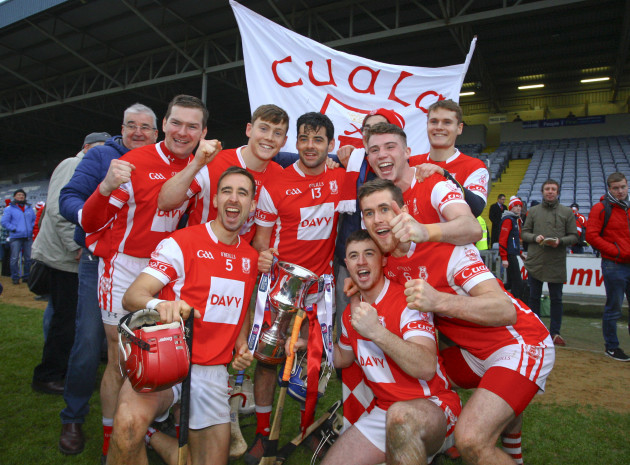THEY MIGHT HAVE operated in fundamentally different spheres, but American soccer and Dublin GAA used to have at least one thing in common: the sense that they would be unstoppable if they ever got their act together.
Lately the Dubs have done so in a big way; the Yanks, or the men’s team at least, not so much.
While Dublin GAA has managed to harness its natural advantages to the tune of five All-Ireland football titles in seven years, US soccer is still coming to terms with failure to qualify for the World Cup for the first time since 1986.
Overcoming its status as a poor relation behind the traditional big four sports was always seen as the big problem for US soccer, but they had some good news on that front this week. A survey by Gallup revealed that soccer now ranks a clear fourth with US fans asked to name their favourite spectator sport, having tripled its popularity in the last decade. American football dominates with 37%, but basketball (11%), baseball (9%) and soccer (7%) are much closer together.
The picture is even better in some key demographics. Soccer ranks joint second with basketball in popularity with 18-34 year olds, and third for 35-54 year olds. The figures continue a trend dating back to the 1994 World Cup and are partially explained by the steady progress of MLS coupled with the glamorous appeal of the big European leagues, as well as the success of World Cup-winning women’s teams. But they also provide a clue as to the national team’s current travails.
Because while the fortunes of Dublin GAA and US soccer have diverged since the days when both had sleeping giant status, there is another unlikely parallel between the two: both enjoy a middle-class power base and struggle to make an impact in poorer communities.
The subject of class crept onto the GAA agenda recently with the huge success of clubs such as Cuala from wealthier Dublin areas and the contrasting struggle to make ground in the capital’s working-class soccer strongholds.
Comments by chief executive John Costello in his fiery annual report last month make it clear that Dublin GAA feel a moral obligation to reach those less well off, but the Dubs push towards poshness has done little harm to their fortunes on the field. Not so with our friends across the water.
The Gallup survey showed that soccer reaches its highest level of popularity among the subgroup describing themselves as politically ‘liberal’ — an allusion to the fact that it is increasingly a favoured game of America’s affluent suburban elite.
In the soul-searching within the US soccer community following their World Cup qualification failure, one phrase in particular was repeatedly mentioned: pay-for-play. A by-product of soccer’s popularity with richer Americans, this is the system whereby parents must pay hefty fees to have their talented children play with top juvenile clubs, accessing the best coaching and enjoying better odds of being spotted by scouts from colleges or MLS academies.
Pay-for-play’s negative impact is obvious. It prevents the sport from penetrating urban communities, particularly the African-American areas that produce so many athletes in other codes, while also disenfranchising those in soccer-mad, poorer Latino neighbourhoods who also cannot afford access to the system.
US soccer’s failure to capitalise on the latter came into focus this week with the decision of highly rated 18-year-old Jonathan Gonzalez to declare for Mexico. Gonzalez plays with Monterey in the Liga MX but was born and raised across the border in California and represented the USA from U14 to U20 age groups.
“Our Federation lost Jonathan either by its own arrogance, apathy or incompetence,” Brad Rothenberg told the Soccer America website this week. Rothenberg is founder of Sueno Alianza, an annual competition to scout Latino talent, which discovered Gonzalez in 2013.
We screwed up and I’m angry about it. I’ve grown tired of watching our federation neglect this community,” Rothenberg said. “We didn’t do enough, not nearly enough, to keep him. And the worst part is that it will continue if wholesale changes aren’t made in the approach to finding talent in this community. The paucity of coaches employed by US Soccer with an interest in Latino style of play is a problem.”
It’s that absence of Latino influence that many have focused on. While the current men’s team features several Hispanic and African-American players, their prevailing style of football has long been very much pale and stale.
MLS squads and successive national teams have been dominated by white players with modest technical ability. European-influenced coaching philosophies value physicality and organisation over the creativity and technique associated with Latin American football. And kids from Latino communities, like Jonathan Gonzalez, feel disconnected and disinterested in the MLS and the national team as a result.
The whole issue runs deep into the racial and class schisms contorting America at the moment, explaining much about how US society is structured to protect privilege and why issues of immigration and assimilation have caused such difficulty.
Are people like Jonathan Gonzalez not interested in being American, or is America simply not interested in them? When you have a president talking about immigrants coming from “shithole” countries, the inability of US soccer to make the most of its entire player base isn’t so hard to understand.
Still, they say the American future is Latino, regardless of the current political climate, and change is afoot in the US soccer federation, which will elect a new president this year following the decision of Sunil Gulati to step down after the World Cup qualification failure. If they can take advantage of soccer’s ever-increasing popularity and their massive potential resources, the Yanks, like the Dubs, might become unstoppable yet.
The42 has just published its first book, Behind The Lines, a collection of some of the year’s best sports stories. Pick up your copy in Eason’s, or order it here today (€10):


